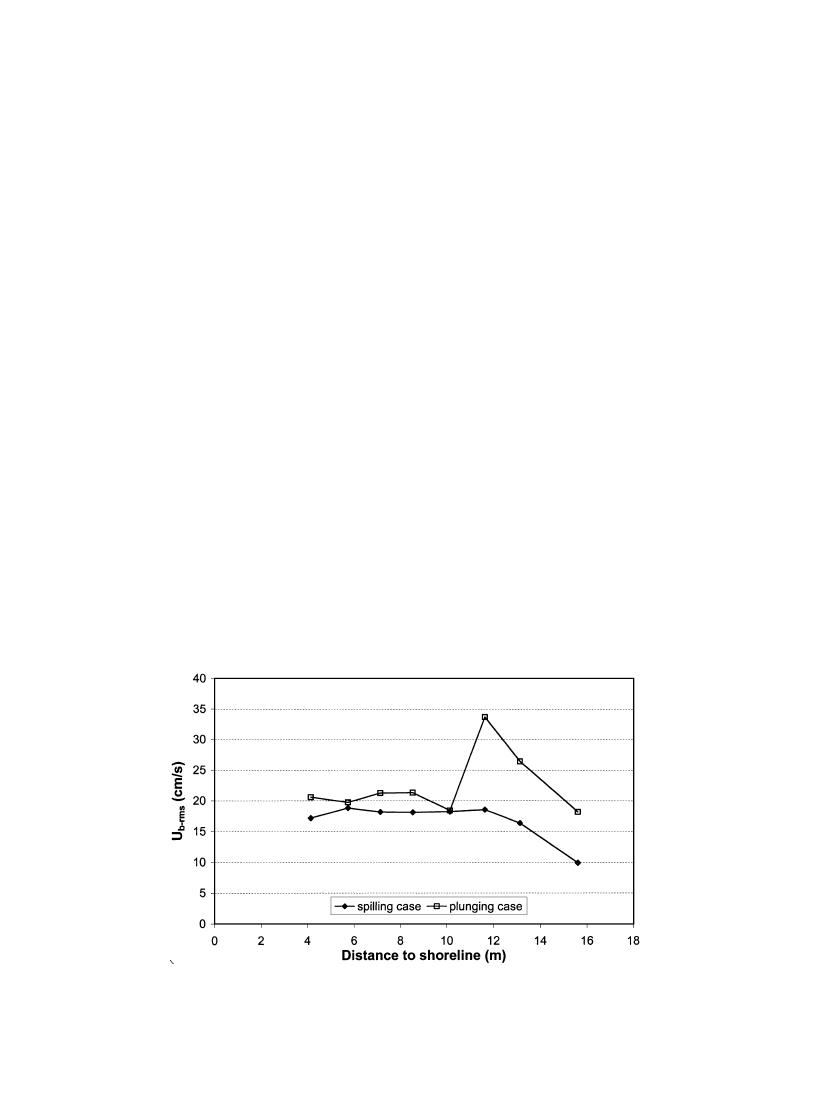
P. Wang et al. / Coastal Engineering 46 (2002) 175211
199
under the plunging breaker compared to the spilling
plunging cases. This similarity across the mid-surf
breaker. Under the plunging breakers, the bed eleva-
zone is reasonable due to similar bed (Fig. 5) and
tion changed drastically in the vicinity of the breaker-
saturated wave conditions (Fig. 2). The mid-surf zone
point bar, from seaward sloping to landward sloping.
was dominated by surf-bore motions for both cases.
Another important factor controlling sediment sus-
pension is the bottom condition, which has strong
(Ub-rms) at 3 cm above bed for both cases. Given the
influence on the bed roughness (e.g., Wikramanayake
small incident-wave angle, Ub-rms should be domi-
and Madsen, 1994a,b). Different bed forms were
nated by the wave-orbital motion. Near-bottom veloc-
measured under the plunging and spilling breakers
ity, which determines the bottom shear stress, is one of
especially in the vicinity of the breaker line (Fig. 5).
the dominant factors in sediment suspension (Nielsen,
For the plunging-wave case, large, irregular ripples
1992). Despite the differences in wave period, Ub-rms
occurred on the seaward slope, and a relatively flat,
in the mid-surf zone are similar for both cases,
featureless bed dominated the bar's crest and land-
apparently regulated by the shallow water depth.
ward slope. Under the spilling breakers, the bed
The remarkable similarity in the time-averaged
elevation remained relatively constant and the surface
sediment concentration at the spilling and the plung-
was covered with reasonably regular ripples with
ing breaker lines (at ADVs 7 and 8), especially within
heights of 1.0 to 1.2 cm and lengths of 6 to 9 cm.
3 cm from the bed, is intriguing. To emphasize this
The hydrodynamic conditions at the plunging and
similarity, the data in Fig. 18 were rearranged in Fig.
spilling breaker lines were also different with much
20. Similar sediment concentrations were measured at
more turbulence generation during the plunging
elevations of 1, 2, and 3 cm from the bed for both
breaking than during the spilling breaking, with the
spilling (solid bar) and plunging (clear bar) cases;
leading edge of the plunging breaker seemingly
while high in the water column, e.g., at 15 cm from
impinging directly on the bottom. These substantial
the bed, concentrations measured under plunging
differences in bed and turbulence conditions resulted
breakers were more than one order of magnitude
in remarkable differences (over one order of magni-
greater than under the spilling breakers (Fig. 20).
tude) in suspended sediment concentration throughout
The water depth and bottom conditions were substan-
the upper 80% of the water column. Based on present
tially different at the breaker lines. The still-water
understanding of sediment fluid interaction, the rel-
depth was nearly 30% shallower at the top of the bar
Fig. 19. Root-mean-square of cross-shore current at 3 cm above bed, for the spilling and plunging cases.



 Previous Page
Previous Page
